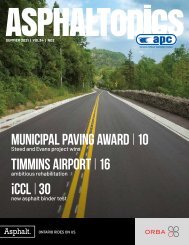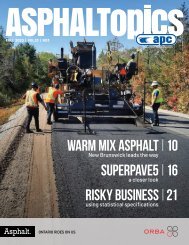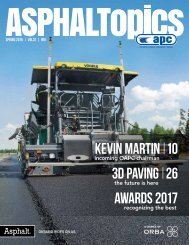ASPHALTopcs | Summer 2017 | VOL 30 | NO 2
You also want an ePaper? Increase the reach of your titles
YUMPU automatically turns print PDFs into web optimized ePapers that Google loves.
mitigating this problem. The asphalt<br />
binder is specifically selected for the<br />
mix design at intersections (PGAC<br />
requirements are normally one-grade<br />
higher for heavy traffic conditions or<br />
for pavement where there are heavy<br />
slow-moving vehicles, and even<br />
two-grades higher for extremely<br />
heavy truck or bus traffic). The PGAC<br />
is commonly enhanced or polymermodified<br />
to achieve these grades.<br />
Aggregate properties need to<br />
be considered just as carefully.<br />
The aggregate structure must be<br />
capable of carrying the load and<br />
developing a high degree of stoneto-stone<br />
interlock to resist shearing.<br />
The need for consistent gradations<br />
is well recognized, but there also<br />
must be consistency in particle<br />
shape, texture and absorption.<br />
Both coarse and fine aggregate<br />
must be angular to provide the<br />
interlock required for rut resistance.<br />
Plastic deformation is similar to<br />
slope failure. Rounded aggregates,<br />
with a low angle of repose, tend to<br />
act like ball bearings and therefore<br />
have much less shear resistance.<br />
Crushed materials, which stay up<br />
in a stockpile, have the necessary<br />
internal friction to resist shear.<br />
Fortunately, Ontario has excellent<br />
aggregate sources that can meet<br />
these quality requirements.<br />
Recent developments in crushing<br />
equipment and techniques have<br />
also helped to improve aggregate<br />
angularity and cubicity. In many<br />
cases, washing, crushing and other<br />
secondary processing can improve<br />
marginal aggregates.<br />
Air voids are particularly important<br />
and should neither be too low<br />
nor too high. Air voids are the air<br />
spaces or pockets of air that occur<br />
in the compacted mix; mixes are<br />
typically designed at four per cent<br />
and produced between three and<br />
five per cent. Mixes with excessively<br />
low air voids can lead to flushing and<br />
potentially result in rutting.<br />
On the other hand, mixes with<br />
high air voids are more prone<br />
to durability problems. If the air<br />
void content is too high, the voids<br />
become interconnected which<br />
allows the passage of air and water<br />
resulting in poor durability. Keep<br />
in mind that density and air void<br />
content are directly related – the<br />
higher the density (or compaction)<br />
the lower percentage of air voids.<br />
Pavements are typically compacted<br />
to eight per cent air voids in-place<br />
(or 92 per cent maximum relative<br />
density). A proper design will<br />
provide sufficient air voids for<br />
stability and sufficient asphalt<br />
cement and volumetric properties<br />
for good long-term performance.<br />
Improper construction techniques<br />
can also lead to rutting. Consolidation-type<br />
rutting occurs when the<br />
pavement has not been sufficiently<br />
compacted. Under traffic loads, the<br />
aggregate particles will reorient<br />
themselves into a denser condition.<br />
Therefore, it may require more effort<br />
to get the necessary compaction<br />
with some of the stiffer mixes (with<br />
enhanced PGAC and aggregate<br />
properties) used for intersection<br />
improvements.<br />
Aggregates are, of course, only<br />
one component of a hot mix (even<br />
if they do make up 95 per cent of<br />
the pavement). It is not just the<br />
characteristics of each component<br />
of the mix, but also the interplay<br />
of those components that provides<br />
high-quality pavement.<br />
Improved asphalt intersections<br />
can be built with minimal delay<br />
for motorists, and while the initial<br />
cost may be higher than the more<br />
conventional asphalt mixes, the<br />
dramatically improved performance<br />
will result in a lower life-cycle cost.<br />
The final product will be a long<br />
lasting, cost-effective, smooth<br />
asphalt intersection and the<br />
answer to one of our biggest<br />
municipal pavement design<br />
challenges.<br />
1. Road Safety in Canada, Government of Canada -<br />
www.tc.gc.ca/roadsafety2011<br />
SUMMER <strong>2017</strong> 35

















